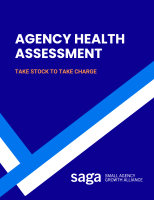As the owner of a small agency, the weight of business development falls on your shoulders. You may be more comfortable providing creative solutions for clients. You may even be comfortable with talking to prospects about their challenges. But drumming up leads and closing deals isn’t the most enjoyable experience for many owners.
Thinking about business development as relationship-building rather than as a traditional sales process can be a helpful mindset shift.
The AIM-GET Framework that I have created as part of the Build to Own approach to help guide agencies includes a focus on creating a sustainable process for growth that makes it a less daunting task.
To understand how well you are positioned to grow your agency over the next year, answer these 5 questions:
Are you satisfied with the amount and quality of new business you have generated in the past 12 months?
Take a realistic look at how your business has grown over the past year.
Did it meet your expectations? At the same time, was the revenue the right kind for your business? Did it come from ideal clients or did you feel forced to take on a client simply because you needed revenue?
Ensuring that you have clients that you can produce consistently great results for while adding reasonable profit to your bottom line is the recipe for sustainable growth.
While past performance isn’t a perfect indicator of future results, it is something that you want to learn from. If you had a great year, what drove it and can you repeat it? If you had a tough go, what will you change to see a different outcome in the months ahead?
Are you confident about your agency’s business development prospects for the next 12 months?
Your pipeline today is a good barometer for the next quarter or two. If you aren’t having active conversations with prospects right now, then you probably won’t see a meaningful bump in revenue for at least 3-4 months.
With that in mind, what does the year ahead look like for you? Do you have a pipeline of prospects already in place? Do you have an action plan to drive growth or do you usually end up just waiting for the phone to ring?
The better you can get at forecasting your growth, the easier it is to make decisions that will help you to scale more effectively. At the same time, a reliable flow of potential new deals helps you to keep your stress in check and your team’s enthusiasm high.
If you aren’t consistently having meaningful conversations with prospective clients (and those who can reasonably refer business) then you need to develop an action plan to address that lack of consistency.
Do each of your clients represent less than 25% of your agency’s annual revenue?
Many – if not most – small agencies have at least one “whale” client that represents more than one-quarter of the total annual revenue. In some cases, it can even be more than half of the total.
While the revenue that these whales provide is welcome, they come with a lot of challenges. Obviously, when a client this large decides to leave (and they all do eventually), it creates a large amount of financial uncertainty for most agencies.
Because of that fear, agencies tend to dramatically overservice the whales to try to keep them around — but that erodes the profit margin and makes the large revenue amount far less beneficial than it seems.
Worse, the focus on retaining that whale (or whales) often leads to owners taking their focus off of developing new business – after all, the concern about losing an ongoing revenue stream usually outweighs the urge to find a new one.
The solution to whale clients isn’t to reduce the money they spend with your agency – it’s to get more similarly sized clients. As you put together your growth strategy, ask how you can find more clients like those (rather than trying to dilute the dependency on the whale by trying to get a larger number of small clients).
Do you believe that your current pricing is competitive?
Most agency owners worry about pricing work too high. However, a race to the bottom from a pricing standpoint creates huge pressures on the agency and tends to inhibit growth substantially.
To test your agency’s price competitiveness, you need to look at deals that you have lost because the client chose someone to do the same work at a lower price.
Don’t just take a prospect’s word for granted when they tell you that you were too expensive. That’s an easy out for many prospects, but only takes on significance when they find someone else who can do similar work for less money.
Your price needs to be at least high enough for your agency to earn a fair profit on the work, but you also want to press until you find a cap for what you offer. (You can learn more about floor-to-ceiling pricing to help guide your thinking.)
Do at least half of the proposals that you create turn into paid projects?
Most agencies create far too many proposals and waste too much time on them.
Proposals should be at the end of the business development process after there has been an agreement on the framework of the work to be done and the price to be paid.
If you only send a proposal when you have had that meeting of the minds, your close rate should be well over 50%. Never let a prospect push you into creating a proposal prematurely. Wait until you have the information and agreement you need to move forward.
If a prospect asks you to send over a proposal after a single conversation, you probably ought to resist. In most cases, you won’t have enough information to ensure that you are a good fit and can provide a solution that will produce the results that the prospect expects.
A potential new client shouldn’t be seeing your ideas – or your price – for the first time in a proposal that you email to them.
Remember that successful new business in the agency world isn’t a game of big numbers, it’s all about having a focus on the best-fit prospects and making sure that you don’t waste your time (or the prospect’s) on deals that aren’t likely to work out.
Conclusion
Agencies depend on new revenue – both to grow the business as well as to replace existing clients lost through normal churn.
The Growth portion of the AIM-GET Framework helps you to think about your approach in a way that makes business development simpler and less painful for owners. Understanding where you are today using the questions in this article will help you to map out a plan for the future that meets your needs and helps you hit your own growth goals.
SAGA’s Agency Health Assessment can help you to look at some of the key drivers of success to identify other areas you may wish to focus on for improvement.










